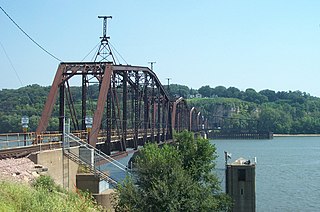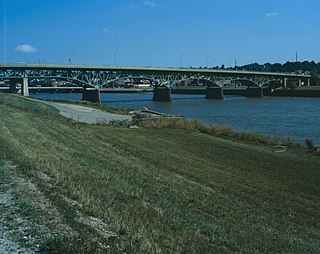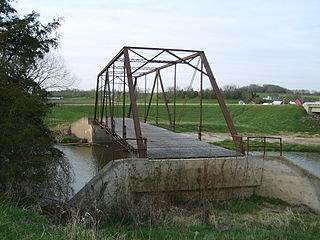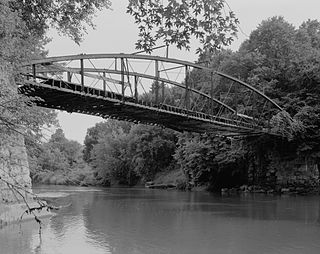
The Dubuque Rail Bridge carries a single rail line across the Mississippi River between Dubuque, Iowa, and East Dubuque, Illinois, near river mile 580. It is currently operated by Canadian National Railway as a result of their 1999 purchase of Illinois Central Railroad.

The Dubuque County Jail is a historic building at 36 East 8th Street in Dubuque, Iowa, United States. Completed in 1858, the jail is an example of the uncommon Egyptian Revival style. It is architecturally a highly original work of John F. Rague, who also designed the 1837 Old Capitol of Illinois and the 1840 Territorial Capitol of Iowa. The building was designated a National Historic Landmark for its architecture in 1987. It served as a jail for more than a century, became a museum in 1975, and was converted into county offices in 2016.

Bridge L-158 is a disused railroad bridge over Muscoot Reservoir near Goldens Bridge, New York, United States. Built to carry New York Central Railroad traffic over Rondout Creek near Kingston, it was moved to its current location in 1904.

The Burlington, Cedar Rapids and Northern Railway (BCR&N) was a railroad that operated in the United States from 1876 to 1903. It was formed to take over the operations of the bankrupt Burlington, Cedar Rapids and Minnesota Railway, which was, in turn, the result of merging several predecessor lines, the construction of which began in 1869. The corporate headquarters were in Cedar Rapids, Iowa, and it had operations in Iowa and in Minnesota. It was succeeded by the Chicago, Rock Island and Pacific Railway.

The Fremont Mill Bridge near Anamosa, Iowa was built in 1873. Its superstructure was designed and built by Massillon Iron Bridge Company and its foundations were built by James Milne. It is a wrought iron bowstring through arch bridge.

The Pine Mill Bridge is an historic structure located in Wildcat Den State Park in rural Muscatine County, Iowa, United States. It was built in 1878 near the Pine Creek Gristmill, the only place in Iowa where a mill and bridge combination remains in place. The bridge was listed on the National Register of Historic Places in 1998 as a part of the Highway Bridges of Iowa MPS.

The Upper Paris Bridge is a historic structure located near the town of Coggon in rural Linn County, Iowa, United States. The pin-connected Whipple through truss bridge was built in 1879 as a wagon bridge. It was designed by the Wrought Iron Bridge Company of Canton, Ohio. The bridge was listed on the National Register of Historic Places in 1998 as a part of the Highway Bridges of Iowa MPS.

The Jefferson Street Viaduct is a historic structure located in Ottumwa, Iowa, United States. The riveted Warren deck truss bridge was completed in 1936. It was listed on the National Register of Historic Places in 1998 as a part of the Highway Bridges of Iowa MPS.

The Wapsipinicon River Bridge is a historic structure located in Independence, Iowa, United States. It spans the Wapsipinicon River for 341 feet (104 m). The Buchanan County Board of Supervisors contracted with the Miller-Taylor Construction Company from Waterloo, Iowa, to build the new bridge on the south side of Independence for $37,680. However, high water created problems during construction, and the bridge was completed in January 1927 for $57,530. It replaced an earlier two-span iron truss bridge. This bridge is a concrete filled spandrel arch bridge with four spans. It was designed by the Iowa State Highway Commission, and continues to carry vehicle traffic. The bridge was listed on the National Register of Historic Places in 1998. There is a similar bridge upstream in Independence that was built in 1918.

The Kilbourn Bridge is located south of Kilbourn, Iowa, United States. It carried traffic on Lark Avenue over the Des Moines River for 855 feet (261 m). In 1890, the Van Buren County Board of Supervisors contracted with the Western Bridge Company of Chicago to build a bridge at the Kilbourn ferry crossing. It was destroyed in a flood in 1903, and the Board of Supervisors put off replacing the bridge until 1907, then all the proposals came over the $20,000 limit. They removed the limit the following year. The six-span bridge was designed by the Iowa State Highway Commission (ISHC), and built by the Ottumwa Supply and Construction Company of Ottumwa, Iowa. It was the first large-scale engineering project undertaken by the newly formed ISHC. The Kilbourn Bridge was listed on the National Register of Historic Places in 1998.

The Elkader Keystone Bridge is a historic structure located in Elkader, Iowa, United States. The old iron truss bridge that crossed the Turkey River at this location was declared unsafe in 1888. The Clayton County Board of Supervisors decided to construct a bridge of native limestone as way of saving money and providing a reliable crossing. Engineer M. Tschirgi designed the structure and Dubuque stonemasons Byrne and Blade constructed the bridge. It was built at a cost of $16,282, and spans the river for 346 feet (105 m). This is one of the largest twin arched keystone bridges west of the Mississippi River. A sidewalk was added on the north side of the structure in 1924. The bridge was individually listed on the National Register of Historic Places in 1976.

The Twin Bridge is a historic structure located in Twin Bridge Park southwest of Fayette, Iowa, United States. It spans the Little Volga River for 80 feet (24 m). The Fayette County Board of Supervisors contracted with N. M. Stark and Company of Des Moines to build almost all of its bridges between 1900 and 1913. This concrete Luten arch bridge was completed in about 1910 using a patented design by Indianapolis engineer Daniel Luten. Stark was a licensee for Luten and they built multiple bridges using his designs under a patent royalty agreement. The Twin Bridge was listed on the National Register of Historic Places in 1998.

Mill Race Bridge is a historic structure located northwest of Eldorado, Iowa, United States. It spans the Turkey River for 120 feet (37 m). Its name is derived from its location near a riverside mill. Horace E. Horton, a civil engineer from Minneapolis, had designed wagon bridges for Fayette County in the 1880s. When he joined the Chicago Bridge & Iron Company late in the decade, he took the county with him as a client. Chicago Bridge & Iron was responsible for providing the county's bridges in the 1890s. This bridge was completed about 1892, but its concrete abutments are not original. While it remains in place, but it has been replaced by a newer span. The Mill Race Bridge was listed on the National Register of Historic Places in 1998.

Hale Bridge is a historic structure located south of Anamosa, Iowa, United States. It spans the Wapsipinicon River for 296 feet (90 m). It is an example of a bowstring through-arch truss bridge. Perhaps thousands of these bridges were built in Iowa in the late 1860s through the 1870s. However, by 1992, fewer than twenty survive.
Moore's Ford Bridge was a historic structure located northeast of Monticello, Iowa, United States. It spanned White Water Creek for 100 feet (30 m). The Jones County Board of Supervisors received a petition for a bridge at this location in September 1877. While they agreed there was a need, they put off erecting a bridge here until other bridges in the county were completed at major crossings. They finally authorized this bridge in September 1883 and contracted with the Morse Bridge Company of Youngstown, Ohio to erect a single Pratt through truss span here. It was completed in June 1884 for $2,305. The bridge was listed on the National Register of Historic Places in 1998. It has subsequently been taken down.

Corbett's/Eby's Mill Bridge is a historic structure located northeast of Scotch Grove, Iowa, United States. It spans the Maquoketa River for 128 feet (39 m). James S. Applegate established a gristmill near this location in 1858. He was joined by John Corbett, who obtained ownership by 1868 and expanded the operation and added a sawmill. He petitioned the Jones County Board of Supervisors for an iron bridge at this location in 1870. They agreed to pay two-thirds of the construction costs with the final third paid for by local subscriptions. The contract to construct this bridge and a similar span in Monticello was made with Miller, Jamison & Company of Cleveland. Both are single span bowstring truss bridges that were completed in November 1871. This bridge has always been identified with the mill. Samuel Eby acquired it in 1875, and it remained in the family until 1913. The bridge was originally on a loop road that circled behind the mill pond. When County Road X73 was created in 1958 it bypassed the bridge to the south. The bridge has been under private ownership ever since. It was listed on the National Register of Historic Places in 1985.

The Dunkerton Bridge is a historic structure located in Dunkerton, Iowa, United States. The span carried a local street over Crane Creek for 212 feet (65 m). The three-span, filled spandrel arch bridge was built by the Marsh Engineering Company of Des Moines in 1909. It replaced an older span at a different location. The bridge served as the major entry point into the town from the north. This bridge was also replaced by a newer bridge to the east, and this span now carries pedestrian traffic between Charma Park and Marble Street into downtown Dunkerton. It was listed on the National Register of Historic Places in 1998.

The Winnebago River Bridge was a historic structure located north of Mason City, Iowa, United States. The span carried U.S. Route 65 over the Winnebago River for 122 feet (37 m). This is the second span at this location. The stone abutments from the previous bridge were utilized in this one. They were sheathed in concrete by the Concrete Engineering Company, and William Henkel of Mason City constructed the bridge. It is composed of three concrete spans with a 70 feet (21 m) center span cantilevered from shorter anchor spans. It was listed on the National Register of Historic Places in 1998. A second span has subsequently been built to the east in 1969.

Keigley Branch Bridge is a historic structure located northeast of Gilbert, Iowa, United States. It spans the Keigley Branch for 47 feet (14 m). The Iowa State Highway Commission was re-formed in 1913 and they developed standard designs for smaller bridges. One of their designs was an alternative to the Luten arch. They were built throughout the state in the 1910s and 1920s. This is the oldest remaining arch bridge from that era. The Koss Construction Company of Des Moines completed it in 1913 for $3,384.85. The bridge features a medium-span arch with concrete-filled spandrels, paneled guardrails, a corbeled arch ring, and two-tone concrete detailing. The Keigley Branch Bridge was listed on the National Register of Historic Places in 1998.
The Fish Creek Bridge is a historic structure that was originally located east of Salem, Iowa, United States. The span carried Hickory Road over Fish Creek for 50 feet (15 m). It is a small-scale, wrought-iron bridge that the Henry County Board of Supervisors bought from the George E. King Bridge Company of Des Moines in 1893 for $410.80. It was believed to have been fabricated by their parent company, King Iron Bridge Company of Cleveland, and assembled by local laborers. Its historical significance derived from its being an uncommon variant of the Pratt truss. It was listed on the National Register of Historic Places in 1998. Subsequently, the bridge has been replaced at its original location, and the historic structure was moved to Oakland Mills Park.






















